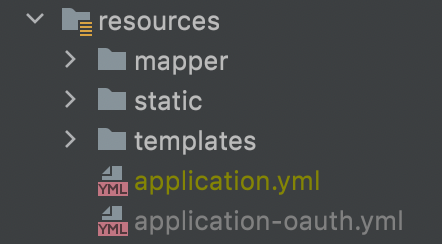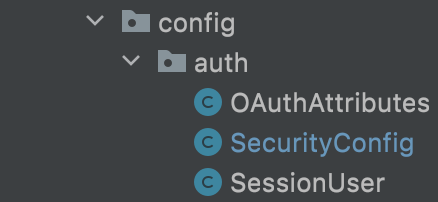소셜 로그인 기능을 추가해서 사용자의 입력을 받으려 한다.
JPA가 아니라 MyBatis를 사용하는 프로젝트이다.
구글에서 받은 clientId 와 clientSecret yml에 등록하기

application.yml
spring:
...
profiles:
include: oauthapplication.yml에 위의 코드를 추가한다.
application-oauth.yml
spring:
security:
oauth2:
client:
registration:
google:
client-id: [자신의 구글 클라이언트 아이디]
client-secret: [자신의 구글 클라이언트 비밀번호]
scope: profile,emailapplication.yml에 있는 위치에 application-oauth.yml을 생성하고 위의 코드를 추가한다.
scope는 자신이 구글 서비스에서 신청한 범위 목록을 작성하면 된다.
새로만든 application-oauth.yml도 잊지말고 꼭 .gitgnore에 등록해줘야 한다. 안 그럼 중요한 구글 클라이언트 아이디랑 비밀번호가 다 공개된다... (만약 공개됐다면 구글 서비스를 다시 신청하는 게 맘 편하다..!)
.gitgnore에 application-oauth.yml 을 적어주면 된다.
사용자 정보를 담당할 User 도메인 생성하기

User
@Getter
@NoArgsConstructor
public class User{
private String name;
private String email;
private Role role;
@Builder
public User(String name, String email,Role role) {
this.name = name;
this.email = email;
this.role = role;
}
public User update(String name) {
this.name = name;
return this;
}
public String getRoleKey() {
return this.role.getKey();
}
}
각 사용자의 권한을 관리할 Role 클래스도 생성해준다.
Role
package com.Matchurkorea.Match.domain.User;
import lombok.Getter;
import lombok.RequiredArgsConstructor;
@Getter
@RequiredArgsConstructor
public enum Role {
GUEST("ROLE_GUEST","손님"),
USER("ROLE_USER","일반 사용자");
private final String key;
private final String title;
}
스프링 시큐리티 설정하기
build.gradle에 스프링 시큐리티 관련 의존성을 하나 추가한다.
implementation 'org.springframework.boot:spring-boot-starter-oauth2-client'스프링 시큐리티 관련 클래스 작성

이제 OAuth 라이브러리를 이용한 소셜 로그인 설정 코드를 작성한다.
config.auth 패키지를 생성한다. 앞으로 시큐리티 관련 클래스들을 모두 이곳에 담아 관리한다.
OAuthAttributes
@Getter
public class OAuthAttributes {
private Map<String,Object> attributes;
private String nameAttributeKey, name, email;
@Builder
public OAuthAttributes(Map<String,Object> attributes,
String nameAttributeKey,
String name,String email){
this.attributes=attributes;
this.nameAttributeKey=nameAttributeKey;
this.name=name;
this.email=email;
}
public static OAuthAttributes of(String registrationId,
String userNameAttributeName,
Map<String, Object> attributes) {
return ofGoogle(userNameAttributeName, attributes);
}
public static OAuthAttributes ofGoogle(String userNameAttributeName,
Map<String, Object> attributes) {
return OAuthAttributes.builder()
.name((String) attributes.get("name"))
.email((String) attributes.get("email"))
.attributes(attributes)
.nameAttributeKey(userNameAttributeName)
.build();
}
public User toEntity() {
return User.builder()
.name(name)
.email(email)
.role(Role.GUEST)
.build();
}
}
SecurityConfig
@Configuration
@EnableWebSecurity
public class SecurityConfig extends WebSecurityConfigurerAdapter {
private final CustomOAuth2UserService customOAuth2UserService;
public SecurityConfig(CustomOAuth2UserService customOAuth2UserService) {
this.customOAuth2UserService = customOAuth2UserService;
}
@Override
protected void configure(HttpSecurity http) throws Exception {
http
//csrf 차단 해제
.csrf().disable()
.headers().frameOptions().disable()
.and()
.authorizeRequests()
.antMatchers(
"/error",
"/favicon.ico",
"/**/*.png",
"/**/*.gif",
"/**/*.svg",
"/**/*.jpg",
"/**/*.html",
"/**/*.css",
"/**/*.js",
"/",
"/home/**",
"/test/**"
.permitAll()
.antMatchers("/mytravel/**").hasRole(Role.GUEST.name())
.anyRequest().authenticated()
.and()
.logout().logoutSuccessUrl("/")
.and()
.oauth2Login().userInfoEndpoint().userService(customOAuth2UserService);
}
}권한에 따라 자신의 웹서비스를 어디까지 공개할지 작성해준다.
.permitAll()은 회원가입하지 않은 유저도 확인할 수 있는 페이지이고 .hasRole(Role.GUEST.name())은 권한을 가진 유저만 접속할 수 있는 페이지를 설정해준 것이다.
SessionUser
package com.Matchurkorea.Match.config.auth;
import com.Matchurkorea.Match.domain.User.User;
import lombok.Getter;
import java.io.Serializable;
/*
* 세션에 저장하려면 직렬화를 해야 하는데
* User 엔티티는 추후 변경사항이 있을 수 있기 때문에
* 직렬화를 하기 위한 별도의 SessionUser 클래스 생성
*/
@Getter
public class SessionUser implements Serializable {
private String name, email, picture;
public SessionUser(User user) {
this.name = user.getName();
this.email = user.getEmail();
}
}
CustomOAuth2UserService
@RequiredArgsConstructor
@Service
public class CustomOAuth2UserService implements OAuth2UserService<OAuth2UserRequest, OAuth2User> {
private final userMapper userMapper;
private final HttpSession httpSession;
@Override
public OAuth2User loadUser(OAuth2UserRequest userRequest) throws OAuth2AuthenticationException {
OAuth2UserService<OAuth2UserRequest, OAuth2User> delegate = new DefaultOAuth2UserService();
OAuth2User oAuth2User = delegate.loadUser(userRequest);
// 현재 로그인 진행 중인 서비스를 구분하는 코드
String registrationId = userRequest
.getClientRegistration()
.getRegistrationId();
// oauth2 로그인 진행 시 키가 되는 필드값
String userNameAttributeName = userRequest.getClientRegistration()
.getProviderDetails()
.getUserInfoEndpoint()
.getUserNameAttributeName();
// OAuthAttributes: attribute를 담을 클래스 (개발자가 생성)
OAuthAttributes attributes = OAuthAttributes
.of(registrationId, userNameAttributeName, oAuth2User.getAttributes());
User user = saveOrUpdate(attributes);
// SessioUser: 세션에 사용자 정보를 저장하기 위한 DTO 클래스 (개발자가 생성)
httpSession.setAttribute("user", new SessionUser(user));
return new DefaultOAuth2User(
Collections.singleton(new SimpleGrantedAuthority(user.getRoleKey())),
attributes.getAttributes(),
attributes.getNameAttributeKey()
);
}
private User saveOrUpdate(OAuthAttributes attributes) {
User user;
if(userMapper.findByEmail(attributes.getEmail())!=null){
user=userMapper.findByEmail(attributes.getEmail());
}
else {
user=attributes.toEntity();
userMapper.save(user);
user=userMapper.findByEmail(attributes.getEmail());
}
return user;
}
}saveOrUpdate 메소드를 통해 findByEmail로 유저가 이미 존재하는지 확인하고 존재하지 않는다면 유저의 정보를 저장한 후 반환하고 유저가 존재한다면 db에서 유저의 정보를 가져와 반환한다.
userMapper 작성하기
userMapper
@Mapper
public interface userMapper {
//로그인 & 회원가입
User findByEmail(String email);
void save(User user);
}userMapper.xml
<?xml version="1.0" encoding="UTF-8"?>
<!DOCTYPE mapper PUBLIC "-//mybatis.org//DTD Mapper 3.0//EN" "http://mybatis.org/dtd/mybatis-3-mapper.dtd">
<mapper namespace="com.Matchurkorea.Match.mapper.userMapper">
<insert id="save" useGeneratedKeys="true" keyProperty="id">
INSERT INTO user.user(name,email,role) VALUES(#{name}, #{email}, #{role})
</insert>
<select id="findByEmail" resultType="com.Matchurkorea.Match.domain.User.User">
SELECT * FROM user.user WHERE email = #{email}
</select>
</mapper>
안녕하세요! 다름이 아니라, application-oauth.yml 깃허브에 커밋 해버렸는데,, "구글 클라이언트 아이디랑 비밀번호가 다 공개된다... (만약 공개됐다면 구글 서비스를 다시 신청하는 게 맘 편하다..!)" -> 이렇게 말씀해주셨는데요!! 구글 서비스가 구글 클라우드에서 받는걸 말씀하시는거 맞으실까요? 아니면 제 구글 아이디를 말씀하시는걸까요 ㅎ... 비전공자라 좀 무섭네요 ㅎ...